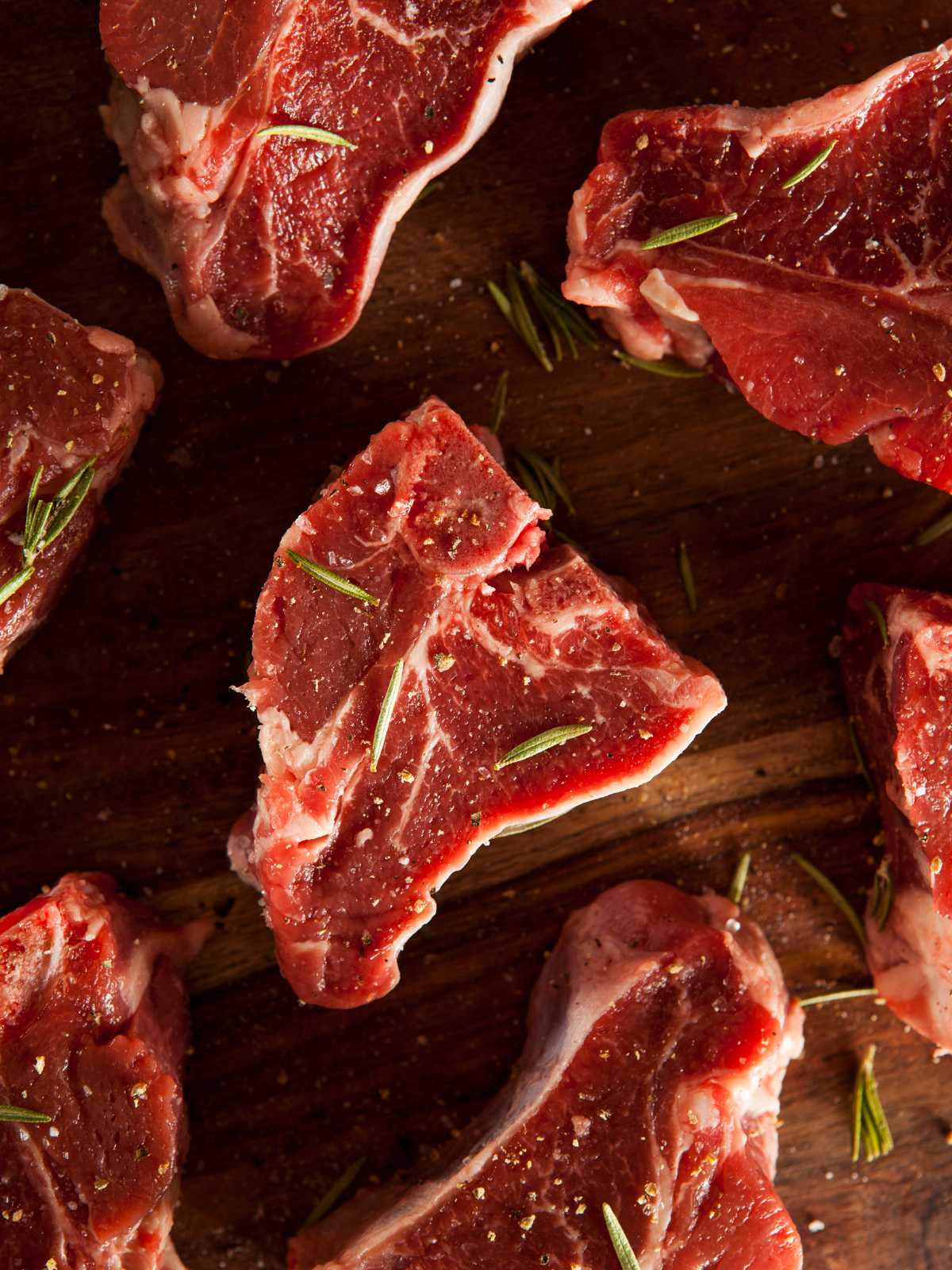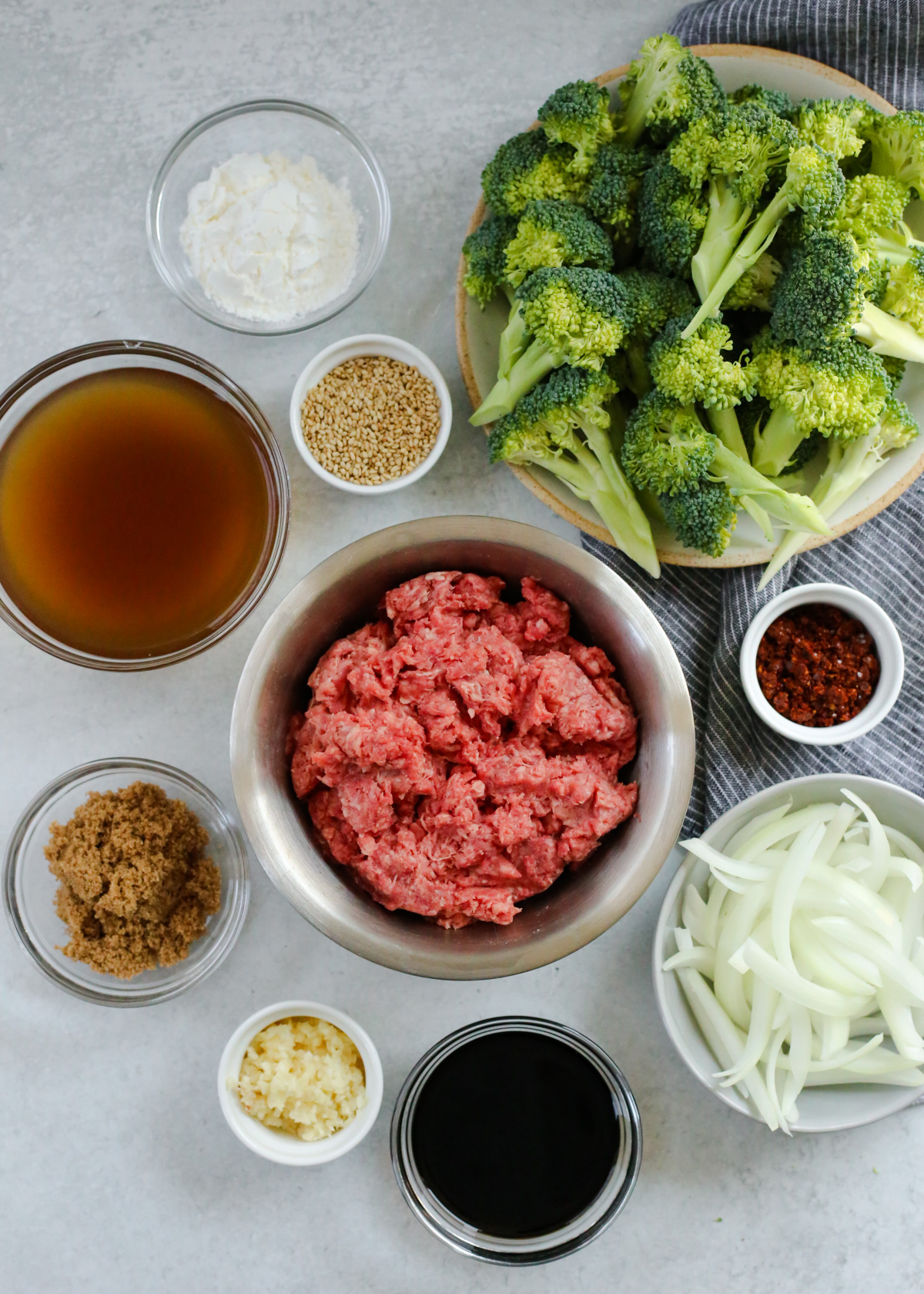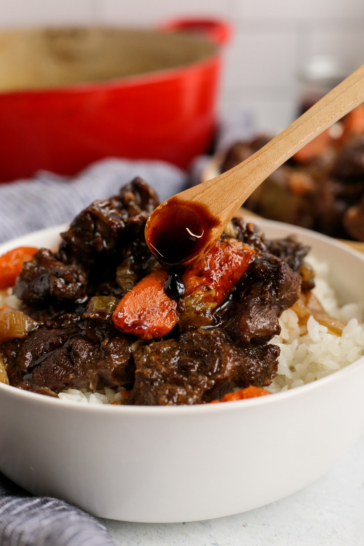When it comes to lamb vs. beef, which do you choose?
From a perfectly cooked steak to an impressive rack of lamb, these proteins rank high for taste, quality, and nutrition. But with so many options (and the rising cost of groceries) you might be wondering what to buy.

Good news: this is your complete guide to understanding the key differences between lamb vs. beef!
If you’re new around here, a warm welcome to you! I’m Cara Harbstreet, MS RD LD, a Kansas City-based registered dietitian and the owner of Street Smart Nutrition. As an advocate for fearlessly nourishing meals, I hope this leaves you feeling confident about your choice at the grocery store or farmer’s market.
When it comes to red meat options, both beef and lamb can be delicious and nourishing. However, in terms of flavor, cost, availability, and sustainability they can differ quite a bit.
In this guide to lamb vs. beef nutrition, I’ll break down everything you need to know so you can make an informed choice when you’re shopping. Use the links in the table of contents to jump ahead to the section you’re looking for!
What I’ll Cover in This Guide

How Popular Are These Proteins?
On average, we eat just over a pound of lamb per year.
In the United States, beef is far more common than lamb.
Compare that to the nearly 60 pounds of average beef consumption per year and there is a clear favorite animal protein.
The trends on protein intake do vary by age; Gen Z tends to prioritize more plant-based meals than baby boomers.
Now, let’s take a peek at the nutrient similarities and differences between beef and lamb.
Nutritional Value of Lamb vs. Beef
If you’re aiming for the most nourishing protein, the good news is that these two choices are pretty darn similar.
Whether you choose lamb or beef, both protein-rich foods have more in common than differences in terms of calories, protein, vitamins, minerals, and other essential nutrients (1, 2, 3, 4, 5, 6). Both are complete proteins, meaning they provide all of the essential amino acids. And both are considered a type of red meat, unlike other types of meat like poultry or seafood.
It is important to point out that the nutrients – especially the total fat and calories – depend on the cut of meat for both beef and lamb; a sirloin steak is leaner than most options of ground beef. However, the vitamins and minerals will be similar with all cuts of steak.
| Nutrition in a 3 oz portion | Ground Beef | Ground Lamb | Average daily requirements |
| Calories | 250 | 280 | Varies |
| Protein | 18 g | 16 g | Varies |
| Fat | 20 g | 23 g | Varies |
| Carbohydrates | 0 g | 0 g | Varies |
| Iron | 2 mg | 1 mg | 18 mg |
| Magnesium | 16 mg | 21 mg | 350 mg |
| Zinc | 4 mg | 3 mg | 8 mg |
| Vitamin B12 | 2 mcg | 2.5 mcg | 2.4 mcg |
| Choline | 67 mg | 70 mg | 425 mg |
| Niacin | 5 mg | 6 mg | 14 mg |
Beef and lamb also provide selenium, riboflavin, and vitamin B6 in addition to the important nutrients listed above. Note that the type of iron in both beef and lamb is heme iron. This is a more bioavailable, or more absorbable form of iron compared to the non-heme iron found in plant foods. If you stick to a plant-based, vegetarian, or vegan diet, be sure to get enough iron from a variety of sources to avoid iron deficiency.
Choosing Lean Cuts
I recommend opting for lean cuts of lamb or beef whenever possible. The American Heart Association recommends limiting saturated fat, which is the type of fat that can raise your risk of heart disease. But the fat content of beef and lamb also include some monounsaturated fat, the type of fat that can support heart health. Red meat consumption isn’t the only thing that influences cardiovascular health, so if you have risk factors for heart disease, check with your healthcare team about changes you can make to your diet.

Grass or Grain?
Did you know that the overall nutrients in meat are also impacted by what the animal ate? Cows and sheep are both ruminant animals that evolved to eat grass. When animals eat grass, their meat tends to be relatively leaner and their growth (and therefore time to slaughter) takes longer (7).
In modern farming techniques, especially in the United States, cows may be fed grain mixtures that help them to grow more quickly. However, all cattle raised for beef starts out on pasture for the first few months of life. The meat from grain-finished cows tends to be a bit higher in fat than grass-finished cows.

Grass-finished cows have a slight edge nutritionally; they tend to have higher levels of omega-3 fatty acids than grain-finished (8). And overall lamb tends to be richer in omega-3 fatty acids than beef, especially ALA (alpha-linoleic acid). Something that made me chuckle as I was researching this article is that some farmers call lamb “land salmon” because of its rich omega-3 content (9).
Having said that, there is also a range of how much omega-3s are in lamb based on what the lamb ate – just like with cows. Some farmers are experimenting with giving their lambs feed rich in omega-3 content before slaughter and are finding that the harvested meat has a higher concentration of omega-3s than in the fully grass-fed lamb (10).
The bottom line: these minor nutritional differences shouldn’t be the only factor in your decision. As a dietitian, I recommend other ways to get plenty of omega-3s (including plant-based options). So next, let’s turn our focus to the question of sustainability.

Environmental Impact of Lamb vs. Beef
Let’s start by saying this: the environmental impact of beef vs. lamb is a BIG topic with a lot of nuance.
Farming practices aren’t a simple issue that can easily be summarized into one section of a blog post. I’ve written about this before in my posts about the Beef Sustainability Roundtable and my “Meat of the Matter” series because there was just so much info to cover!
Needless to say, there are lots of different factors that impact how eco-friendly a choice is. Plus, our own thoughts, beliefs, and values impact what we think is important. But part of fearlessly nourishing meals (my tagline, by the way!) is about gathering enough information to feel like you’re making a conscious and informed food choice.
Looking for local meat is one way to lessen the environmental impact of any food choice, including eating meat. If you have the time and budget for it, you can look for a local farmer to purchase your meat from (more on finding a local farmer in a bit – stay tuned).
If a food has traveled for 100s or 1,000s of miles, that inherently takes more energy than something grown close by. Taking it one step further; if the beef you purchase was raised on a farm in South America, the land was probably rainforest before becoming a cattle farm (11).
Street Smart Nutrition Tip: Be aware that if meat is “processed,” or passes through a USDA-inspected plant, which is a requirement for all imported beef, it can be labeled as a product of the U.S. (12). I know that’s confusing, so if country of origin is important to you, you’re better off identifying the location of the company or brand or looking for an “American Grassfed Association” logo.
What about those greenhouse gases? Raising conventional cows releases twice as much of the harmful greenhouse gasses as lamb, but keep in mind that this data includes the dairy cows that are raised for milk and cheese production (13).
In grass-fed farms, the grasses can help mitigate the gases by trapping them; therefore grass-fed beef and lamb may have a lower impact than feedlot beef (14).
According to the Water Footprint Network and other organizations, raising beef takes about twice as much water as raising lamb (15, 16).
Another factor is if you are eating the whole animal. Anytime we can reduce waste is a benefit for the environment. It may be a more eco-friendly choice to purchase a whole animal from a local farmer and have a stocked freezer for months and months.
One last factor to consider is the risk of waste. Think about the egg price hike in 2023 – this was because of losing many MILLIONS of hens to avian flu. When we have giant monoculture systems they may be more vulnerable to pests and diseases (17).
While there are many different ways to quantify environmental impact, lamb tends to be a more eco-friendly choice than beef. And we create an environmental impact through more than just our food choices. It’s also fair to critique the sustainability of our cars, clothing, housing, and travel & shopping habits to lessen the negative effect on the environment.
Comparing Costs of Lamb vs. Beef
There are a lot of moving factors that impact that grand total on your grocery store receipt. Including which protein sources you choose. And lately, the first thing I think about when shopping is my budget. Keep in mind that prices vary depending on where you live, where you shop, and a nearly infinite number of other factors.

In general, lamb is going to be a bit more expensive than beef. On top of that:
- Organic options will usually be more pricey than non-organic
- Grass-fed will be more expensive than grain-fed
- Lamb or beef from a small family farm (such as purchasing meat from a farmer’s market) will be more expensive than buying meat from a larger growing operation
- Certain cuts (like a whole rack of lamb or filet mignon) will cost more per pound than ground lamb or stew meat
Lastly, the price of beef might vary on the fat content, especially with regards to ground beef. Most of the time, ground beef with a higher fat content (called 80/20 beef in the grocery store) will be a bit less expensive than lean beef (for example, 90/10 ground beef). Ground lamb usually doesn’t offer as much variety with fat percentages.
Comparing Lamb vs. Beef Flavor
Both beef and lamb are earthy and delicious.
Beef might have a bit more familiar and mild flavor than lamb. Lamb might have a slightly stronger flavor that could be described as earthy or even gamey or “funky”. I don’t say this in a bad way! It’s not spoiled or rotten. But it’s a noticeably different flavor you’ll pick up on if you’re new to eating lamb.
I recently tried smoked lamb ribs from a local BBQ spot. They were just as juicy and fall-off-the-bone tender as other ribs, but smaller in size and definitely had a unique and recognizable lamb flavor.
And remember how we talked about how beef and lamb can both be raised in different ways in terms of being grass-fed, grain-fed, or a combo of the two? Grain-fed beef and lamb are both a bit fattier and tend to be more tender than grass-fed. Fat carries flavor so this can potentially intensify all the other seasonings or spices in your recipes.

As a dietitian who values flavor, I’ll always encourage you to eat based on what your personal preference is. If you simply don’t like the flavor of either one, you can switch to a completely different option and still enjoy high-quality protein with your meal.
Is your mouth watering yet? If you’re ready to get cooking, I’ll guide you through how to start sourcing lamb and beef from local ranchers!
How to Find Local Farmers
So, how do you connect with local farmers? There are some great databases! For example, visit Local Harvest and enter your zip code and you will see what farms are near you.
You can also search for a local farmer’s market. This is an opportunity for you to try some of these products and talk to the men and women directly involved on the farm. They might also offer a discount if you purchase a bulk amount.
If you have the space in your budget (not to mention your freezer), this is a way to stock up on local proteins.
Street Smart Nutrition Tip: Going the extra step to source local lamb or beef is a nice way to keep your dollars in your community. But I know it’s not an option for everyone, which is why I’ll never recommend avoiding lamb or beef from your local grocery store. There are even convenient grocery pick-up or delivery options now, so no matter where you make your purchase, just be sure to get it back in the fridge or freezer for food safety.
Recipe Inspiration for Home Cooks
Now it’s time for the fun part! If you made it through all this information about lamb vs. beef nutrition, you probably worked up an appetite. Or, at the very least, some interest in cooking with lamb or beef. Let’s start with a few popular cuts to look for as you’re shopping:
- Beef: Ground beef, sirloin steak, ribeye steak, beef tenderloin, beef stew meat, skirt steak, flank steak, and boneless beef short ribs are just a few popular favorites
- Lamb: Ground lamb is one of the easiest cuts of lamb to find (fresh or frozen) but you’ll also see lamb chops, lamb shanks, rack of lamb, and lamb roasts
Cooking lamb can seem intimidating if you’ve never done it before. But there’s good news! You can use the same cooking methods for both beef and lamb.
Try grilling, roasting, braising, or slow cooking. Plus ground beef and ground lamb make great additions to stews or chili. Moving onto recipes, try these suggestions and you might find a new favorite!

Must-Try Beef Recipes
- Easy Ground Beef and Broccoli Stir Fry Recipe (This is a fan favorite!)
- Ground Beef Stroganoff (without Cream of Mushroom Soup)
- Braised Beef Neck Bones with Chinese Five Spice Pomegranate Glaze
- Skirt Steak Salad with Miso-Ginger Dressing
Recommended Lamb Recipes
- Lamb Chili Recipe for the Stovetop or Slow Cooker
- Greek Lamb Gyro Skillet
- Grilled Lamb Loin Chops with Corn on the Cob and Grilled Romaine
- Spiced Lamb Burgers with Tzatziki Sauce

Quick cooking tip: if you’re cooking grass-fed beef or lamb, it is likely a bit leaner. Be careful to not overcook the meat at high temperatures or you’ll be disappointed by the tough, dry, chewy texture.
I recommend keeping an eye on the internal temperature of meat with a good thermometer. Cook your meat enough to the temperature needed to reduce your risk of food poisoning but not more than that. A perfectly cooked lamb or beef dinner is juicy and delicious.
For ground beef and lamb, the recommended internal temp is 160 degrees Fahrenheit. For both beef and lamb steaks, roasts and chops the minimum safe internal temperature is 145 degrees (18).
The Bottom Line to Find the Best Option For You
As we’ve been able to take a peek, the comparison of beef vs. lamb isn’t a black-and-white answer. While beef is typically more affordable than lamb, beef may have a bigger environmental impact.
And while many of the nutrients are pretty similar between the two animal proteins, lamb may be richer in omega-3 fatty acids.
In either case: both kinds of meat offer you an abundance of protein, vitamin B12, zinc, and choline. They both taste great, are available in any grocery store, can be stored in the freezer, and prepared in a multitude of different ways.
What do I choose? Both! It’s not a matter of beef vs. lamb in my opinion. Both can be a good choice if you enjoy them and want to include them in your diet.
More Food Guides and Ingredient Comparisons
I hope you found this article to be helpful. I want you to be able to make the best decision for your kitchen. One that’s based on your own taste preferences, budget, and unique priorities.
The best answer for you might well be different than another person’s. That’s what makes nutrition education so exciting to me as a registered dietitian. It isn’t my job to tell you what to eat, it is my privilege to provide you with evidence-based information. That way you can make the best choice for you!
You can learn more about some other favorite ingredients with these posts:
- Alaskan vs. Atlantic Salmon: Your Best Guide for What to Buy
- Cold Brew Coffee vs. Espresso: Ultimate Guide for Coffee Lovers
- Radicchio vs. Red Cabbage: Health Benefits and How to Use
Is there another food or drink that you’d like to learn about? Comment below with your requests; I’d love to know what you’re interested in learning more about.













